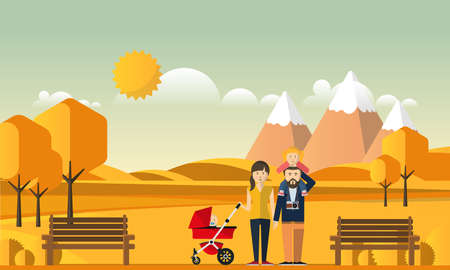Introduction: Navigating the World of Baby Gear
When you’re expecting a new baby or juggling life with a little one, choosing the right stroller setup can feel overwhelming. For American families who are always on the go—whether it’s running errands around town, hitting up local parks, or planning family road trips—the decision between travel systems and standard strollers isn’t just about convenience. It’s about what truly fits your lifestyle.
Think of it this way: Your stroller isn’t just a piece of baby gear; it becomes a trusty sidekick for all those everyday adventures and big milestones. From quick Target runs to strolls along Main Street, your choice can make things smoother or add unexpected stress. That’s why it matters so much to pick something that works with your daily routine, car size, storage space, and how often you’re out and about.
Here’s a quick look at some real-life scenarios many American families face when choosing between travel systems and standard strollers:
| Lifestyle | Travel System | Standard Stroller |
|---|---|---|
| Busy city living, lots of walking | Convenient car seat transfer, but bulkier for public transit | Lighter and easier to maneuver in tight spaces |
| Frequent road trips or driving | Easy to move baby from car to stroller without waking them | Might need separate car seat adapter or solution |
| Limited storage at home or in car trunk | Takes up more space with extra pieces | Slimmer profile, folds smaller for tight spots |
| Growing family (multiple kids) | Some models adapt as family grows, but not all do | More single options, though double versions exist too |
The choices may seem endless, but understanding how each option lines up with your daily routine helps narrow things down. In the next sections, we’ll dive deeper into what makes travel systems and standard strollers unique—so you can feel confident about whichever path is best for your family.
2. What is a Travel System?
When you’re shopping for baby gear in the U.S., you’ll probably hear a lot about “travel systems.” But what exactly are they, and why do so many American parents swear by them? Let’s break it down in plain English.
How Travel Systems Work
A travel system is basically a set that combines an infant car seat with a stroller. The magic here is that the car seat clicks right into the stroller frame—no need to unbuckle or wake up your sleeping baby when you move from car to sidewalk (or vice versa). For busy families on the go, this can feel like a lifesaver.
What’s Included?
| Component | Description |
|---|---|
| Infant Car Seat | Secures your baby safely in your vehicle; often rear-facing for newborns |
| Stroller Base/Frame | Wheels and handlebar; designed to easily accept the car seat |
| Stroller Seat | Some models also include a regular stroller seat for when your child outgrows the infant seat |
The Hallmark: Convenience
This combo is all about making life easier. Imagine running errands—your baby falls asleep during the car ride, and instead of risking a meltdown by moving them, you simply lift the car seat out and snap it onto the stroller. No fuss, no drama.
Why American Parents Love Travel Systems
- Smooth Transitions: From car to store, doctor’s office, or park without waking your little one.
- One-and-Done Shopping: You get everything you need for early outings in one purchase—no need to mix and match brands or worry about compatibility.
- Urban and Suburban Friendly: Whether you’re city-hopping on public transit or loading groceries in suburbia, travel systems fit the fast-paced lifestyle of many American families.
- Peace of Mind: Designed for safety and ease, most major brands undergo strict testing to meet U.S. safety standards.
Common Scenarios Where Travel Systems Shine
| Scenario | Why It Works Well |
|---|---|
| Grocery Store Runs | No need to wake up baby—just move the car seat from base to stroller in seconds. |
| Pediatrician Visits | Easily navigate offices and waiting rooms with a click-in system. |
| Coffee Shop Meetups | Your baby stays comfy while you sip with friends or catch up on emails. |
| Traveling by Airplane or Uber/Lyft | The car seat doubles as an FAA-approved seat and makes hopping into rideshares simple. |

3. What is a Standard Stroller?
When you’re navigating the world of baby gear in the U.S., you’ll hear about “standard strollers” all the time. These are the classic, everyday strollers most parents picture when they think about strolling through the neighborhood, heading to the park, or running errands at Target. But what exactly makes a standard stroller stand out, and why do so many American families stick with this tried-and-true option?
Exploring the Classic Stroller
Standard strollers are designed to be your daily go-to ride for your little one. Unlike travel systems that include a car seat and stroller combo, standard strollers are typically just the stroller itself. They come in a range of styles—from super lightweight models for city living to sturdier options built for long walks on suburban sidewalks.
What Sets Standard Strollers Apart?
| Feature | Standard Stroller | Travel System |
|---|---|---|
| Main Use | Everyday strolls, errands, parks | Car-to-stroller convenience for infants |
| Weight | Varies (lightweight to full-size) | Often heavier due to car seat attachment |
| Age Range | Newborn (with recline) or 6+ months up to toddler years | Newborns (with car seat) up to toddler years |
| Ease of Folding | Usually simple one-hand fold designs | Somewhat bulkier, may need more steps to fold/unfold |
| Customization | Add-ons like snack trays, parent consoles, rain covers | Focuses on car seat compatibility features |
| Price Range | $60–$600+ | $150–$900+ |
Strengths for Everyday US Routines
If you’re picturing morning coffee runs, trips to local playgrounds, or long strolls around your favorite shopping mall, a standard stroller is often the most convenient pick. Many parents appreciate how these strollers:
- Maneuver easily: Great wheels and ergonomic handles make them comfortable to push over sidewalks and through store aisles.
- Offer roomy storage: That big basket underneath? Perfect for diaper bags, groceries, or your Starbucks order.
- Adapt as your child grows: With multiple recline positions and adjustable footrests, they can work from infancy (with proper support) through toddlerhood.
- Simplify daily life: Most models are quick to fold up and toss in your trunk—ideal for spontaneous outings or busy schedules.
Why Do Parents Gravitate Toward Standard Strollers?
The real reason many American parents choose standard strollers comes down to versatility and simplicity. For families who don’t need to pop a car seat in and out constantly—or whose baby is past the newborn stage—a standard stroller can feel lighter, less bulky, and more straightforward. Plus, with so many styles and brands available at stores like BuyBuy Baby or on Amazon, it’s easy to find something that fits your budget and lifestyle.
In short: if you want an everyday stroller that keeps up with your routine—whether you’re downtown or in suburbia—a standard stroller might just be your perfect match.
4. Comparing the Pros and Cons
When it comes to picking between a travel system and a standard stroller, American parents have plenty of real-life experiences to share. Let’s break down the pros and cons side by side so you can see which might fit your family’s lifestyle best.
| Travel Systems | Standard Strollers | |
|---|---|---|
| Convenience | Super convenient for newborns—just click the infant car seat in and out, making errands or daycare drop-offs a breeze. | No car seat compatibility unless bought separately. You’ll need to move your baby from car seat to stroller, which can be tricky if they’re asleep. |
| Lifespan | Grows with your baby: use from birth through toddlerhood, but some parents say their kids outgrow the car seat piece quickly. | Often last longer for daily walks or bigger outings; some models hold kids up to 50 lbs, so you can use them well into preschool years. |
| Portability | Tends to be bulkier, especially when traveling or packing into smaller cars. Some parents find them a hassle at airports. | Lighter and easier to fold up, making them popular for city living or families who are always on the go. |
| Cost | You get both stroller and car seat, often saving money over buying each separately. But higher upfront cost compared to basic strollers. | Generally cheaper upfront, but you may need to buy other gear (like a car seat) separately. |
| Style & Features | Lots of matching sets with coordinated looks, but sometimes fewer bells and whistles than high-end standard strollers. | More options for design, wheels, suspension, storage baskets, and sun shades—great for parents who want specific features. |
Real-Life Stories from U.S. Parents
Katie in Chicago: “I loved my travel system when my son was little—it made Target runs so easy! But once he hit about 9 months, I switched to a lightweight stroller for getting around the city.”
Mike in Texas: “We skipped the travel system and just got a sturdy jogging stroller since we love hiking on weekends. We used a convertible car seat from day one—it was less convenient at first but worked for our active lifestyle.”
Susan in California: “My husband drives an SUV and I drive a compact car. The travel system fits fine in his trunk but not in mine! We ended up buying a second, more compact stroller just for my daily errands.”
Main Takeaways on Everyday Trade-Offs
- If you’re juggling multiple kids or daycare drop-offs, travel systems save time and keep nap schedules intact.
- If you live in a walkable neighborhood or take public transit often, a lighter standard stroller could be your best friend.
- Bigger families—or those with limited storage—sometimes end up owning both types as needs change!
5. Factors to Consider Before You Buy
Choosing between a travel system and a standard stroller isn’t just about style or brand—it’s about what fits your everyday American lifestyle. Here are the key questions you should ask yourself before making this big purchase:
How Dependent Are You on Your Car?
If you’re living in suburbia or any car-dependent area (hello, most of the U.S.), a travel system could be a game-changer. You can move your sleeping baby from the car to the stroller without ever unbuckling them—super helpful when running errands or doing daycare drop-off.
What’s Your Urban vs. Suburban Life Like?
City parents who rely on public transit or walk everywhere may find that standard strollers are lighter, more compact, and easier to maneuver in tight spaces like subway stations or crowded sidewalks. Meanwhile, travel systems might feel bulky when navigating apartment buildings or hopping in and out of cabs.
What’s Your Budget?
| Type | Average Price Range | What’s Included |
|---|---|---|
| Travel System | $200–$600+ | Stroller + infant car seat (and adapters) |
| Standard Stroller | $100–$400+ | Stroller only; car seat sold separately if needed |
If you want everything bundled together and don’t mind spending a bit more up front, travel systems offer convenience and value. But if you already have a car seat (maybe it’s handed down from an older sibling), buying just the stroller might be easier on your wallet.
Are You Planning for More Kids?
If you’re hoping to grow your family soon, think long-term! Some travel systems and strollers can convert to accommodate two kids (like adding a second seat or standing board). Look for models labeled “convertible” or “expandable.” This saves money and hassle down the road.
Quick Checklist: Essential Questions
- Will I mostly be driving or walking?
- How much space do I have at home and in my car?
- Is portability (like folding with one hand) important to me?
- Do I need something lightweight for travel or public transport?
- Am I planning for more children soon?
- What’s my realistic budget for this purchase?
No matter where you live—from New York City apartments to sprawling Texas suburbs—asking these questions will help you choose the stroller setup that truly fits your life as an American parent.
6. Making the Right Choice for Your Family
Picking between a travel system and a standard stroller isn’t just about reading reviews or chasing the latest trends—it’s about what truly fits your family’s everyday routine, values, and dreams. Here are some warm, practical tips to help you feel confident as you decide what works best for your unique journey.
Think About Your Daily Life
Start by imagining your typical day. Do you spend lots of time driving around town, or are you big fans of long walks in the neighborhood? Is your trunk space limited, or do you have plenty of room for gear? If you’re always on the go—dropping off at daycare, running errands, or traveling—many American parents find that a travel system makes transitions smooth. But if you mostly stroll around parks or city sidewalks, a standard stroller might be all you need.
Consider Your Values and Priorities
Every family is different. Maybe convenience is key for you, or maybe you’re focused on style, budget, or eco-friendliness. Take a moment to talk with your partner (or even friends who’ve been there!) about what matters most to you. Here’s a quick comparison to help:
| Travel System | Standard Stroller | |
|---|---|---|
| Best For | Families who value convenience and seamless car-to-stroller transitions | Families who want a lighter, simpler option for everyday walks |
| Price Range | Higher (includes car seat + stroller) | Usually lower (stroller only) |
| Lifespan | Grows with baby from newborn through toddler years | Mainly for babies who can sit up independently (6+ months) |
| Storage & Size | Bigger and heavier; needs more trunk space | Lighter and easier to fold/store |
| Travel-Friendly? | Great for frequent drivers/travelers | Easier for public transit and urban living |
Ask Yourself These Questions
- How often will I need to move my baby from car to stroller?
- Do I want something that lasts from infancy through toddlerhood?
- Is easy storage and portability more important than having an all-in-one solution?
- What is my budget—and does it include both a car seat and stroller?
- What does my daily environment look like: suburban streets, city sidewalks, or hiking trails?
The Bottom Line: Trust Yourself!
No two families are exactly alike, so don’t worry if your choice looks different from your neighbor’s. Whether you pick a travel system or a standard stroller, know that you’re making the best decision for your little one based on your real-life needs—not just what looks good online. You’ve got this!


